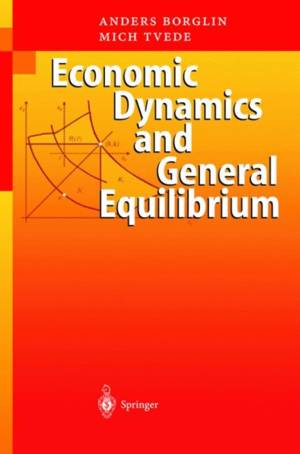
Bedankt voor het vertrouwen het afgelopen jaar! Om jou te bedanken bieden we GRATIS verzending aan op alles gedurende de hele maand januari.
- Afhalen na 1 uur in een winkel met voorraad
- Gratis thuislevering in België
- Ruim aanbod met 7 miljoen producten
Bedankt voor het vertrouwen het afgelopen jaar! Om jou te bedanken bieden we GRATIS verzending aan op alles gedurende de hele maand januari.
- Afhalen na 1 uur in een winkel met voorraad
- Gratis thuislevering in België
- Ruim aanbod met 7 miljoen producten
Zoeken
€ 52,95
+ 105 punten
Uitvoering
Omschrijving
This book grew out of the teaching and lecture notes for a course in "Dynamic Economics" given at Copenhagen University where it has been part of a combined study program in economics and mathematics since 1986. The subjects in the course have varied over time but a common theme has been the study of economies over time and under uncertainty in the form of incomplete markets and the overlapping generations model. When I took up a position at Lund University in 1996 Mich Tvede took over responsibility for the course and together we developed a large part of the material, which formed the basis for the present book. He has generously allowed me to use all of our common material. There is a considerable overlap between general equilibrium theory with incomplete markets (GEI), finance and macroeconomic theory, which sterns from the considerations of time and uncertainty, as can be seen from the splendid textbooks by LeRoy and Werner [2001], Pliska [1997] and the seminal work on GEI by Magill and Quinzee [1996], in partic- ular its "Historical Remarks" which off er a brilliant history of modern economic theory. The exposition here airns at making some of the results of GEI and on overlapping generations (OG) economies readily available to areader acquainted with economic theory at an upper undergraduate level.
Specificaties
Betrokkenen
- Auteur(s):
- Uitgeverij:
Inhoud
- Aantal bladzijden:
- 396
- Taal:
- Engels
Eigenschappen
- Productcode (EAN):
- 9783642055409
- Verschijningsdatum:
- 30/11/2010
- Uitvoering:
- Paperback
- Formaat:
- Trade paperback (VS)
- Afmetingen:
- 156 mm x 234 mm
- Gewicht:
- 576 g

Alleen bij Standaard Boekhandel
+ 105 punten op je klantenkaart van Standaard Boekhandel
Beoordelingen
We publiceren alleen reviews die voldoen aan de voorwaarden voor reviews. Bekijk onze voorwaarden voor reviews.












